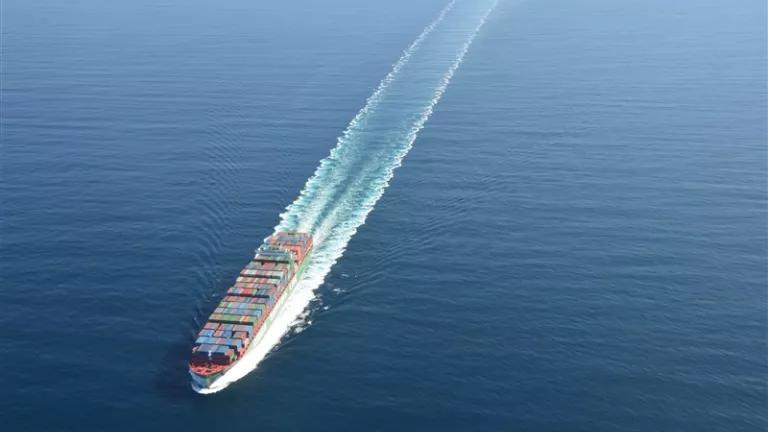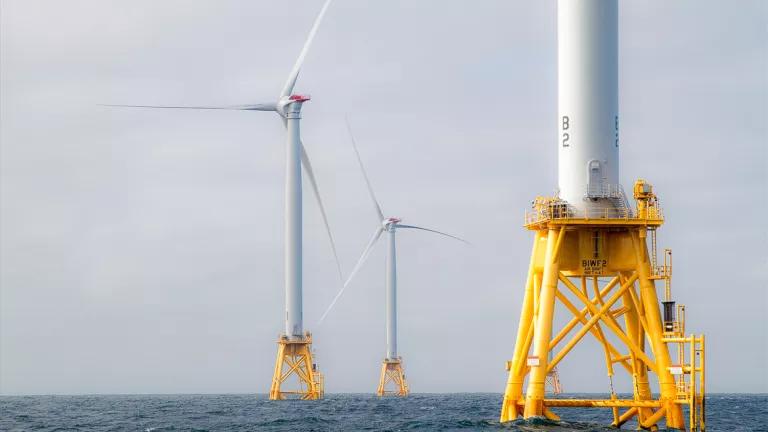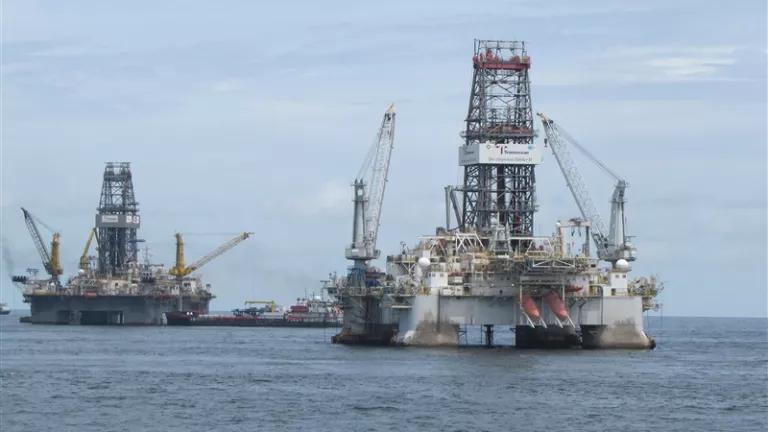Reimagining What it Means to be a Zero-Emission Ship
We can successfully design and build vessels that are quiet and carbon-free, but we must be intentional about it.

Container ship transiting through the Santa Barbara Channel.
The 2022 Our Ocean Conference, held recently in Palau, brought together countries from around the world to discuss and commit to actions to protect the ocean, the life-giving source of food, livelihoods and recreation for much of humanity. A significant part of the discussions focused on the ocean-climate nexus, and the role of international shipping in securing global ocean health.
The U.S., the European Union, Chile, Australia, Japan and others issued new commitments to accelerate the decarbonization of the shipping sector, in part by establishing new zero-emission shipping routes, or so-called “Green Corridors”. The first such Green Corridor partnership was launched in January, and focuses on the route between the Port of Shanghai and the Port of Los Angeles.
As the Global Maritime Forum noted at the Conference, decarbonizing shipping requires a “total shift in fuels and technologies” to power ocean-going vessels, and zero emission vessels must be operating “at scale and on a commercial basis within this decade.” Green shipping corridors present an opportunity to spur innovation and rapid adoption of the “zero-emission” technologies and fuels that will lead to a cleaner, greener global maritime fleet.
This transition, while no doubt requiring significant investment, is tantamount to a renaissance of the shipping industry – an opportunity to reimagine and redefine ocean shipping and its relationship not only to the climate and our health, but to our oceans and to marine biodiversity. One simple way to capture the intersectional benefits of clean shipping is to simply expand what we mean by “zero-emission” ships.
Currently, the notion of “zero-emission” ships refers to ships that are powered in ways that eliminate the suite of air pollutants that results from burning fossil fuels – including greenhouse gases as well as other harmful particulate pollutants, like nitrous oxide and black carbon, that create smog and cause wide-spread health effects, particularly in port cities.
However, the concept so far has failed to include another harmful type of emission from ships that is significantly polluting our marine environment: underwater noise emissions.
For whales, fish and many other forms of marine animals, sound is life. Marine animals use song and other sounds to communicate, find mates, navigate, locate prey, and avoid predators. Underwater noise from human activities drowns out these songs and sounds, directly interfering with marine animal’s ability to hear the sounds vital to its existence.
Large ocean-going ships are as loud as jets upon takeoff, emitting around 190 decibels of noise or more once underway. When you multiply this by the 100,000 vessels that comprise today’s global commercial fleet, it’s not hard to see how commercial shipping has become the predominant source of human noise pollution in the ocean. This cumulative noise has, in many areas, degraded the natural ocean habitats that whales and other long-lived marine mammals have evolved in beyond recognition. Several critically endangered whale species, such as the iconic Southern Resident orcas in the Pacific Northwest, and the North Atlantic right whales off the Atlantic Seaboard, will not be able to recover unless harmful ocean noise pollution is abated.
The trends in vessel noise pollution are discouraging. Ocean noise has been doubling each decade since 1950, spurred by the continued expansion of the global shipping fleet. However, the good news about underwater noise pollution is – unlike many other forms of persistent pollution - it goes away as soon as the noise source is turned off.
So, how do we “turn off” vessel noise emissions? While it is not likely we will ever be able to zero-out underwater noise from ships completely, it can be drastically reduced through innovative vessel designs and technologies. Most of a ship’s underwater noise while underway comes from the propeller. The work to propel a ship creates thunderous amounts of noise through a phenomenon called propeller cavitation. Cavitation can be reduced by design changes and the use of various propeller technologies, such as “fin caps”, which were originally designed to enhance fuel efficiency.
While there are overlaps in some technologies – like the “fin caps” mentioned above or wind-assist propulsion – that can both lower noise and greenhouse gas emissions, it is not likely that the zero-emission ships we are working towards will be meaningfully quieter than business as usual unless we proactively commit to designing and building ships that are both quiet and carbon-free.
Society has a unique window of opportunity – the next five to ten years – to transform international shipping. That transformation will require no less than a total shift in the technologies (and fuels) that power ships. It would be a travesty for this rebirth in ship design to forgo the opportunity to address the noise pollution emitted from vessels. If carbon emissions and underwater noise emissions are not tackled in tandem, there is a real risk that the zero-emission vessels plying the globe in 2050 will continue to pollute the ocean with elevated levels of underwater noise, resulting simply in a shift of the pollution burden.
We can successfully design and build vessels that are both quiet and carbon-free, but we must be intentional about it. In order to bring about such intentionality, it is imperative to expand our notion of zero-emission vessels to include underwater noise emissions.
Linking the reduction of greenhouse gas emissions and noise emissions makes sense in the short-term, too. For example, slowing vessel speed can improve fuel efficiency and cut both air and underwater noise. In a win for whales, slowing vessel speeds can also drastically reduce the likelihood of a ship colliding with and killing whales. The Protecting Blue Whales and Blue Skies Initiative, which asks ships transiting along portions of the California Coast to slow to 10 knots, found that in 2020 participating ships contributed to a reduction of over 24,000 metric tons of greenhouse gas emissions, 748 tons of NOx, and four decibels of vessel noise per transit in the region, while lowering the risk of vessel-whale collisions by 35%. Reducing whale mortality has its own climate benefits. Whales accumulate large amounts of carbon in their bodies - each large whale is thought to sequester the equivalent of thousands of trees - and over their lifetime play an important role in removing carbon from the atmosphere and sequestering it in their bodies upon their death.
Other win-win solutions exist as well. Shoreside electric power, which provides power to a ship while at berth so it can cut its main engines, both reduces emissions and underwater noise when ships are at berth. Improved voyage planning and just-in-time arrival programs can reduce congestion, cutting air pollution and the need for vessels to run noisy generators while awaiting their turn at the port. There are important co-benefits to these actions: they can significantly cut the harmful air particulate pollution that is responsible for localized pollution in port communities, many of which are already overburdened and suffering long-standing health impacts.
As the partnerships around the establishment of Green Corridors proliferates – as they should – we encourage all stakeholders to think not only about decarbonizing ships, but about how to truly green shipping.
Earth Day gives us the opportunity to reflect on what is needed to secure a healthy future, not only for ourselves, but for the myriad species with whom we share our blue planet. Reimagining the future of shipping to be free of all harmful emissions, including shipping-induced underwater noise, is a key step towards achieving a healthier planet for all.



